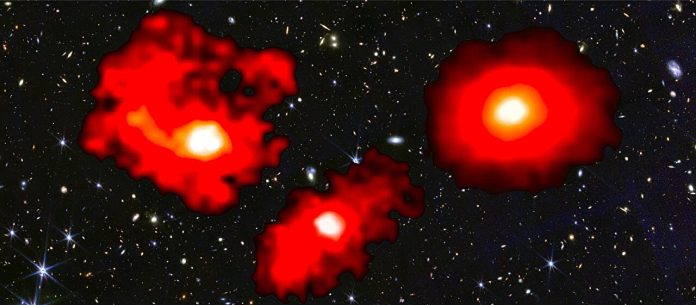
An international team of scientists led by the University of Geneva has discovered three ultra-massive galaxies that formed just a billion years after the Big Bang, challenging existing theories on how galaxies were created in the early universe.
These massive galaxies, almost as large as the Milky Way, are forming stars at an impressive rate and have left astronomers wondering how such large galaxies could have developed so quickly after the universe began.
The discovery was made with the help of the James Webb Space Telescope (JWST) as part of its FRESCO program, which uses advanced imaging tools to measure the distance and mass of faraway galaxies.
These findings, published in Nature, suggest that star formation in the early universe may have been much more efficient than previously thought, posing questions for current galaxy formation models.
Early galaxies and dark matter
Scientists have long believed that galaxies form gradually within massive halos of dark matter, which act like gravitational containers, capturing gas and allowing it to form stars over time.
Current models suggest that only about 20% of this gas turns into stars, limiting how quickly galaxies can grow.
However, these new “red monster” galaxies, as scientists are calling them, appear to have turned much more gas into stars, forming at twice the rate of typical galaxies of the same age.
Using the JWST’s powerful tools, scientists were able to study galaxies from the very early universe, which often appear red in telescope images due to high dust content.
Among the galaxies they examined, three stood out: they were unusually massive and had a distinctive red appearance, leading researchers to nickname them the “red monsters.” These red monsters seem to be forming stars far more efficiently than other galaxies, raising new questions about how galaxies formed so quickly.
Dr. Mengyuan Xiao, the study’s lead author, says these findings are reshaping our understanding of galaxy formation in the early universe. “These massive red monsters would have been hard to detect before the JWST because of the dust that hides them,” Xiao explains.
A milestone in galaxy observations
This discovery is part of a new effort to analyze galaxies from the universe’s first billion years, using the JWST’s specialized NIRCam/grism spectrograph.
This tool lets astronomers precisely measure distances and stellar masses, which helps them understand how these galaxies grew over time. As Dr. Pascal Oesch, principal investigator of the FRESCO program, explains, “The JWST allows us to study how galaxies accumulated mass, giving us a clearer picture of how the universe evolved.”
“Too many, too massive” galaxies?
While these discoveries don’t contradict the standard cosmological model, they challenge existing theories about galaxy formation, particularly the problem of “too many, too massive” galaxies early on.
The rapid growth of these galaxies suggests there may be unique processes at play that allowed some early galaxies to form stars much faster than expected.
Future studies with the JWST and the Atacama Large Millimeter Array (ALMA) will help scientists examine these red monsters in greater detail and potentially discover even more massive early galaxies.
Dr. Xiao believes that as we learn more about these early giants, they will reveal valuable clues about the universe’s first billion years. “The red monsters are just the beginning of a new era in exploring the early universe,” she says, hinting at exciting discoveries yet to come.



